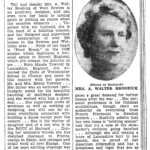Dates of Birth and Death
1893 - 1989Birthplace
Ashton-Under-Lyne, Lancaster, England, UKEducation
- Maud attended the Duke of Westminster School in Chester. She left school after the sixth grade. (She also attended the Albion School in Ashton Under Lyne but only for one year.)
Years of practice
1923–1940 (estimated)Affiliations/Firms
- Brodrick Bros., Newton, MA
Major projects
- Maud H. Brodrick designed and built more than 100 homes, with one newspaper reporting she built approximately 200. Her major projects were 16 estates in Wellesley Hills, MA.
- Houses in Wellesley Hills: 209 Cliff Road (known as Pondbrook); 2, 14, 31, 32, 33, 43 Monadnock Road; 33 Wachusett Road; 14, 15, 21, 26 Peirce Road; 94. 156, 171 Edmunds Road; 72 Windsor Road
Biography
Written by Laura Fitzmaurice. The author earned her degree from Cornell University, College of Architecture, Art & Planning and is currently working as an architectural designer in Newton, Massachusetts. Since 2009, she has been researching and writing about pioneering women architects and builders, including Ann M. Cobb (1830-1911) and Clotilde Brewster (1874-1937) both of whom exhibited their work in the Woman’s Building at the 1893 World’s Fair in Chicago.
A thoroughly self-made woman, Maud Brodrick overcame daunting circumstances to design and build about more than 100 homes in Newton, Wellesley, and other Boston-area suburbs. In 1893 she was born Maud Howard Townley in Ashton-Under-Lyne, a mill town located outside of Manchester, England. Her mother Elizabeth worked as a ring spinner in a cotton mill. Maud’s father Edwin was a carpenter. Maud left school after sixth grade and worked in a cigarette factory, a department store, and a cotton mill.
Maud’s father moved to the United States in 1906 to seek a better life and sent for Maud and her younger sister in 1909. Their mother had joined Edwin the year before. They eventually settled in West Newton, MA. After the move, Maud held a series of jobs, including one at the Waltham Watch factory.
She married an Irish immigrant, Walter Brodrick, in November 1916. In 1923, she and Walter created Brodrick Bros. which was both a real estate agency and a design-build firm. Maud was in charge of the building side of the business: she sketched out designs, hired architects to draft the formal plans, and oversaw construction.
Maud came to have the knowledge and skill of the building trades by working with her father, who had become a housebuilder. She told a reporter from the Boston Herald in the 1940’s that “she worked with him a great deal . . . She supervised crews of workmen as well as working at designing, and still can do almost everything connected with building a house except pour cement.” From a young age she also studied books on architecture and construction on her own.
Around 1930, in the early years of the Great Depression, Maud purchased a large amount of land in Newton and began an intense build campaign. This kept many workers employed during the Depression. Maud also decided that was the time to begin advertising on a grand scale. Her main theme was the superiority of houses designed by a woman. A 1931 ad noted that a home on Allerton Road was “designed, planned by a woman who knows a woman’s needs in a home and who builds into it the innumerable small details that men often overlook.” It was a brilliant marketing move, as these homes continued to sell. A frequently used tagline was: “Woman Planned – Woman Supervised – Brodrick Built.”
Maud also developed Manor House Road in Newton between 1932 and 1934, designing brick homes in the Tudor, French Eclectic and Colonial styles. They retain all the characteristics of her woman centered design – mudrooms, breakfast nooks, butler pantries, and servants’ quarters. She continued to make use of the basements as playrooms with rustic fireplaces and also bars even though Prohibition had not quite ended.
Maud’s most ambitious homes are located in Cliff Estates in Wellesley Hills, designed and built from 1935 to 1938. Maud’s and Walter’s strategy of selling high-end homes to wealthy buyers during the Depression worked until the bank foreclosed on Pondbrook, a baronial estate Maud had developed. This forced her into bankruptcy and ended her building career.
Image Gallery
